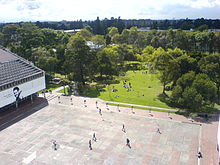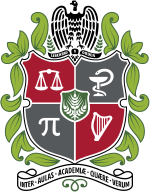|
National University of Colombia
The National University of Colombia (Spanish: Universidad Nacional de Colombia) is a national public research university in Colombia, with general campuses in Bogotá, Medellín, Manizales and Palmira, and satellite campuses in Leticia, San Andrés, Arauca, Tumaco, and La Paz, Cesar. Established in 1867 by an act of the Congress of Colombia,[6] it is one of the largest universities in the country, with more than 53,000 students.[7] The university grants academic degrees and offers 450 academic programmes, including 95 undergraduate degrees, 83 academic specializations, 40 medical specialties, 167 master's degrees, and 65 doctorates. Approximately 44,000 students are enrolled for an undergraduate degree and 8,000 for a postgraduate degree.[8] It is also one of the few universities that employs postdoctorate fellows in the country. The university is a member of the Association of Colombian Universities (ASCUN),[9] the Iberoamerican Association of Postgraduate Universities (AUIP),[10] and the Iberoamerican University Network Universia. Along with Antioquia and Valle universities, it is part of what is known as the Golden Triangle of higher education in Colombia,[11] being among the most selective and competitive universities in the country. The SCImago Institutions Rankings Iber by SCImago Research Group found that the National University of Colombia produced the largest number of scientific papers published in peer-refereed publications in the country, and was the 17th[12] (14th[13] in 2018) most prolific in Latin America. Furthermore, according to the Latin-American Web Ranking of Universities, the National University of Colombia ranks first place in internet presence in the country. It is also among the first universities in the region.[14] Among the universities of CIVETS countries, the National University occupied second place.[15] Globally, the university was ranked #243, and #10 in Latin America by the QS World University Rankings in 2023, placing #2 in Colombia.[16] The institution offers a wide selection of programmes in both undergraduate and graduate levels, such as medicine, nursing, dentistry, engineering, chemistry, pharmacy, mathematics, physics, geology, biology, psychology, social sciences, arts (music, fine arts), languages, philosophy, and law. It was the first university in Colombia to open a computer science postgraduate program in 1967.[17] CampusesBogotá branchThe University City of Bogotá (Spanish: Ciudad Universitaria de Bogotá), also known as the White City (Spanish: Ciudad Blanca), is the flagship University campus. It is located in the Teusaquillo locality, northwest of the historical center. It is also the largest campus in Colombia, with an area of 1,200,000 m2 (300 acres) and a constructed area of 308,541 m2 (76.242 acres), making it an ample campus with several green areas, open spaces, and pedestrian paths. Among its buildings there are 17 which have been declared national monuments and, as a whole, it is a representation of the last 60 years of architecture in Colombia.  The campus was designed by German educationalist Fritz Karsen and architect Leopold Rother, both refugees from Nazi Germany. Construction began in 1935, under the government of Alfonso López Pumarejo. It is organized into an ellipse, divided into five parts, each containing one academic division and its respective departments. From an aerial view, the shape of an owl can be seen, emblematic of a deep connection with wisdom and intuitive knowledge. The buildings were constructed as prismatic blocks, and painted white, in order to give an austere and clean look. Some landmarks in the campus are the León de Greiff Auditorium, and the Francisco de Paula Santander Plaza, also known unofficially as the "Central Plaza". The campus has its own stadium, where matches for the Colombian Professional Football are sometimes held. Medellín branchThe National University of Colombia, Medellín has two campuses, the Central Campus and Robledo Campus, where 10,447 students study. This site provides approximately 29% of the seats for new students at National. Also this site has 555 faculty professors, of which 38% are doctors, 44% are master's, 8% were specialists and 10% are Professionals. This site offers 26 undergraduate and 73 graduate courses: 15 PhDs, 28 Masters, and 29 specializations. [citation needed] Its history has given Medellín a peculiar character, since it was formed, as with most universities, from the classical degrees of Law, Medicine, Arts and Sciences. The site commenced with engineering programs, which is why Medellín today has the highest number of engineering programs (17) among all National University of Colombia campuses and in Colombia in general.[18] Central Campus: Located northwest of the city center, between El Volador hill eco-park and the Medellín River. Since 1938, it has been the headquarters of the National University of Colombia in Medellin, when the School of Tropical Agriculture (now the Faculty of Agricultural Sciences) joined the university. The Central Campus has an area of 272,982 m2, the heart of campus has an area of 31,758 m2 and a portion of El Volador hill, around 269,257 m2. Several learning centers can be found in at the campus including the Entomological Museum which was founded in 1937, the Museum of Mycology founded in 1987, the Herbarium "Gabriel Gutierrez," the wood collection, the Central Library "Efe Gomez" as an attractive artistic and architectural highlights, the Totem Mythic created by Master Pedro Nel Gomez, Block 41 declared a National Cultural, designed by Engineer Jesús Montoya Mejía which began in 1931, Block 11 designed by Master Pedro Nel Gómez. [citation needed] Robledo Campus, also called core or more colloquially as the School of Mines, is located northwest of the city of Medellin, Robledo neighborhood is composed of three fields separated by the 80th street, which presents a difficult high traffic pedestrian connection between the properties that make up the physical structure of the School of Mines, and Ingeominas, recently integrated into the university. It has an area of 100,978.69 m2. In 1886, the School of Mines was created and it was incorporated with the university in 1936, which is called today as the National School of Mines with approximately 3,500 students. It highlights the Museum of Geosciences, Maximum classroom buildings (block M5) and M3 block designed by Master Pedro Nel Gomez School of Mines in 1936. Declared National Monument in 1994 thanks to its architecture and its murals by the same Pedro Nel Gómez. The university in Medellín has 5 faculties of the schools offer 25 careers, nearly half of them are engineering at the School of Mines, also has three museums and other services. [citation needed] Academics
 The National University of Colombia has 20 schools distributed among Bogotá, Medellín, Manizales and Palmira: Departments in Bogotá:
Interfaculty institutes[23]
Museums in Bogotá Campus:
High school (for children of professors, students, and employees):
Departments in Medellín:
Museums in Medellín Campus:
Institutes:
Media:
Noted peopleList of chancellors
Notable alumniFamous personalities among its alumni include:
Gallery
See alsoReferences
External linksWikimedia Commons has media related to National University of Colombia. |
||||||||||||||||||||||||||||||||||||||||||||||||||




















